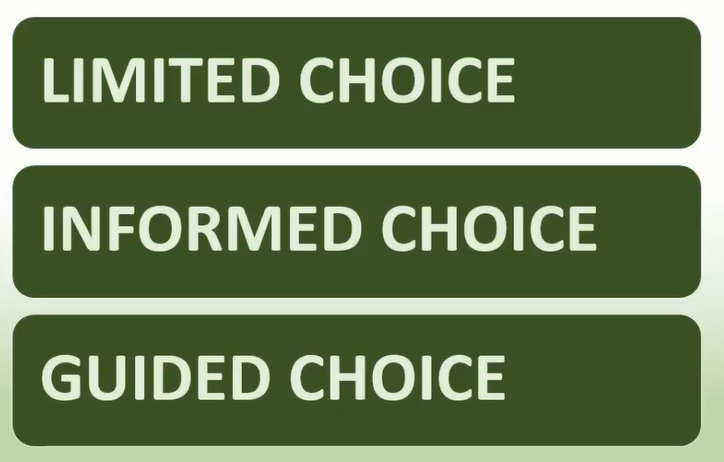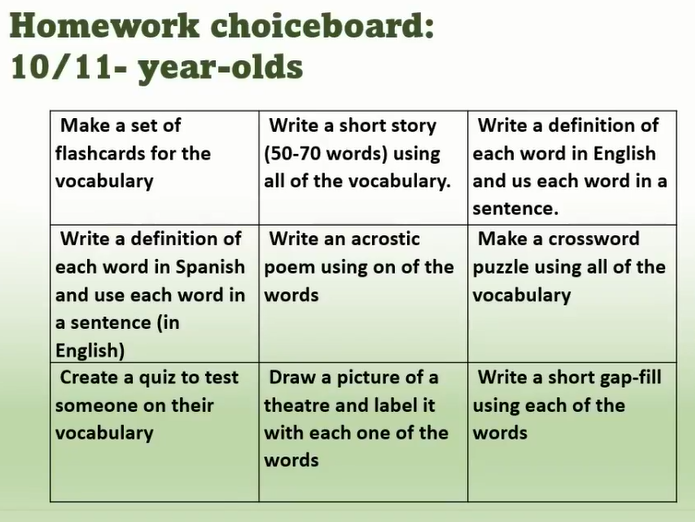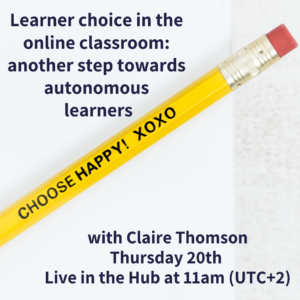Claire Thomson has been teaching for many years and since moving into ELT, has developed a passion for learner choice, which she also worked on for one of the research projects for her Trinity DipTESOL. She looked at choice with three different age groups, starting with a group of 10-11 year olds, a group of teens and a group of adults and the results encouraged her to investigate further. Interestingly, in her research, she’s found that adults tend to be more resistant – possibly due to previous educational experiences. Feedback from the other groups demonstrated that they were more motivated to come to class and to complete homework. Her work started pre-pandemic and so with the shift online she has now been looking at how to incorporate learner choice into the virtual classroom. This is particularly important to take the focus away from the teacher as the main face on-screen.
Choice gives your learners a voice in the classroom, which they so often lack. As Claire highlighted in the webinar, when we think about the choices our learners generally have, many are made for the learners by other people (parents, school policy, teachers):

As one Hub member commented in the chat:
Today’s kids are used to the internet, where choices are infinite. If all that choice is taken away in the classroom situation, it’s like tying their hands behind their backs.
Why? Claire went on to talk about the pedagogical benefits of offering choice:
- promoting a learner-centred approach
- encouraging agency – allowing learners to act and take responsibility for learning
- increased engagement and motivation
- learners take ownership for their learning
- fostering autonomy
- supports differentiation – between levels, abilities, learning styles
- provides a safe environment for them to try new things
- helps learners discover how they learn and develop learning strategies, as well as identifying the tools they need to learn best
- they can find it easier to reflect o their learning as they’re more invested in the process
Who? Learner choice is for EVERYONE!
When? introduce it at any time – and there’s no need to tell them you’re doing it! However, remember that similarly to games, too much of a good thing isn’t great!
What? There are lots of opportunities to offer choice:
- interaction patterns
- homework (deadlines or how to complete)
- activities
- projects
- debates and discussions
- topics and syllabus (perhaps trickier depending on your context)
- testing
- class for that day
How? Overcome the fear – offering choice isn’t giving up control of your classroom.

The choices you offer need to be pre-planned – why are you offering your learners this choice? Is it to motivate them? To allow them more flexibility (e.g. if they have a lot of homework, you might give them a choice of when to hand in work)? What are the advantages and disadvantages of each choice and what’s the benefit for the individual learner?
Remember as well that you should always bear your learning outcomes in mind – the choices you offer should always lead to the same place.
At the start, you might want them to make the ‘wrong’ choice so they can reflect on the process of making the choice and why they need to think critically about the decisions they take.
Also, start simple as you’ll need to put a lot of thought into the choices you offer and planning for learners choice will take much longer. You’ll also need to devote more class time to preparing your learners for making choices so that their choice in informed J
Claire also suggests giving learners time to discuss the options in groups before making an individual choice: this gives them the opportunity to hear other opinions and make a more informed choice.
There was a question about ‘the tyranny of the majority’ which is perhaps less of an issue in the online classroom where choice can be more anonymous. Offering a choice supports quieter students to feel noticed and valued.
Some ideas for how to implement choice:
- Send out a form before class with the choice of the lesson (e.g. letter-writing or passive), with the rationale for why each is important. Remember to make sure that they don’t need to have done one before they do the other!
- Learning stations in the classroom, particularly useful for younger learners
- For exam prep, give them a choice of three reading texts which practise the same part of the exam
- Offering a choice of deadlines for homework – have them look at their schedule so they take responsibility for their learning and develop time management skills
- allowing them to choose how to complete a project (on your own, with a specific person, with A.N.Other, in a group…). Again, explain the effect of each choice, e.g. If you want to work on your own,, you’ll be responsible for completing all the work and do you feel you have time to do this?
- how to show understanding of new vocabulary (multiple choice activity, gapfill, writing a short story, creating your own flashcards)
- Choice boards – an ocean of opportunities!
Claire shared an example of one of the first choice boards she used during her initial research project, which was “an unmitigated disaster”:

However, she was able to reflect on what went wrong and why – an overwhelming amount of choices and not dedicating enough time at the planning stage to explain the choice board and the rationale for it to the learners. She says they spent the entire next lesson discussing this choice board – which led to them being better-informed when the next choice board was offered.
Learning from experience, the best way, thanks for sharing that!
And, learning from experience, Claire showed another homework choice board which was a success:

Rather than leading to a shared learning outcome in terms of linguistic content, this one practised the different task types which they would need to demonstrate in an exam.
Claire shared a blank choice board to allow Hub members to share ideas for a B1 group of adults on the topic of news and media. Here are some ideas which people shared:
- Write a tweet about a news article you have read (no more than … words)
- Make a one minute video explaining the main news items for today
- They can use something like speakpipe instead of filming themselves, speakpipe is only 90 seconds long so could be nice for students: https://www.speakpipe.com/
- Read an article, present it next week to a partner, say why you read it, what you knew about it before reading it, what you learned, how did it make you feel?
Some useful links from Claire and from the chat:
- Poll Everywhere (and a guide on how to use it)
- How to use Microsoft Forms
- How to use Google Forms
- How to use in-meeting polling on Zoom
- How to use polls in Google Meet
- Zoltán Dörnyei who has done a lot of work on motivation
- An article from OUP – Learner Agency: Maximising Learner Potential
- There’s a story on Talking Matters called Choices and the things I have to do which was suggested as a good way to introduce the idea of choice to younger learners
- An article from IATEFL – Offering children choice with technology

1 thought on “Learner choice in the online classroom: another step towards autonomous learners”